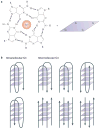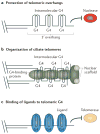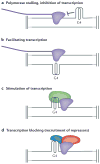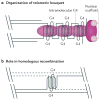DNA secondary structures: stability and function of G-quadruplex structures
- PMID: 23032257
- PMCID: PMC3725559
- DOI: 10.1038/nrg3296
DNA secondary structures: stability and function of G-quadruplex structures
Abstract
In addition to the canonical double helix, DNA can fold into various other inter- and intramolecular secondary structures. Although many such structures were long thought to be in vitro artefacts, bioinformatics demonstrates that DNA sequences capable of forming these structures are conserved throughout evolution, suggesting the existence of non-B-form DNA in vivo. In addition, genes whose products promote formation or resolution of these structures are found in diverse organisms, and a growing body of work suggests that the resolution of DNA secondary structures is critical for genome integrity. This Review focuses on emerging evidence relating to the characteristics of G-quadruplex structures and the possible influence of such structures on genomic stability and cellular processes, such as transcription.
Conflict of interest statement
The authors declare no competing financial interests.
Figures





References
-
- Watson JD, Crick FH. Molecular structure of nucleic acids; a structure for deoxyribose nucleic acid. Nature. 1953;171:737–738. - PubMed
-
- Huppert JL. Structure, location and interactions of G-quadruplexes. FEBS J. 2010;277:3452–3458. - PubMed
-
- Bang I. Untersuchungen über die Guanylsäure. Biochem Z. 1910;26:293–231. (in German)
Publication types
MeSH terms
Substances
Grants and funding
LinkOut - more resources
Full Text Sources
Other Literature Sources

